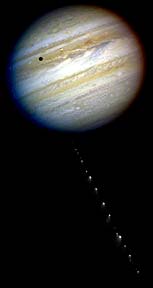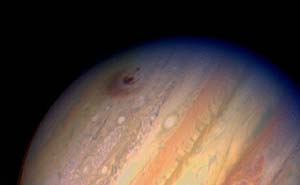|
 Comets Comets
Comets are frozen balls of ice, dust, and rock that usually orbit
far away from the Sun. Occasionally, the orbits of comets are changed
by the gravitational pull of passing stars or other objects, and
the frozen chunks fall down among the planets. As the frozen chunks
approach the Sun, the ices on the surface are heated by sunlight
and flow away, forming beautiful tails like the one above on Comet
Halley in 1986. Image of Comet Halley
courtesy of NASA Goddard Space Flight Center NSSDC.
The solid part
of a comet is usually small, only a few miles across or less. But
some may be large, and their orbits sometimes cross the planets'
orbits, so they may hit a planet. A very small comet exploded above
Siberia in 1908. (Search for: "Tunguska"). A much larger
comet passed close to Jupiter a few years ago and broke into about
twenty pieces. These pieces formed a string of comets like cars
on a track that looped around and crashed back into Jupiter.
Composite image of Comet Shoemaker-Levy and Jupiter
courtesy of NASA/JPL.
As each piece
of comet slammed into Jupiter's atmosphere, it made a giant explosion
visible from the Earth. The series of images below show a sequence
taken from the Galileo spacecraft, while on its way to Jupiter.
You can see the fireball form and then fade. It may not seem very
impressive until you realize that the planet is Jupiter, and that
the fireballs are almost as large as Earth!

The comets exploded
in Jupiter's atmosphere, so they did not make permanent craters
(Jupiter has no solid surface). But they did leave huge blotches
of dust floating in the atmosphere that were visible for months.
Images courtesy of NASA Goddard Space
Flight Center NSSDC.

If you want
to learn more about these collisions with Jupiter, try a search
for: "Shoemaker-Levy 9".
Back
|










